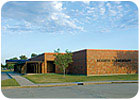
A combination desiccant dehumidification unit
and DX system was used to control humidity inside three Texas City Independent
School District elementary schools during chiller changeouts, as well as to
provide a light cooling load that made the environment more comfortable for the
custodians performing remodeling projects and other summer maintenance work.
HVAC upgrade projects, such as chiller changeouts, are best done in suitable weather conditions that include appropriate temperatures and dry air. Unfortunately, that’s not always possible in southeastern Texas.
Such was the challenge facing Ronnie Martin, energy manager/HVAC supervisor for the Texas City Independent School District. Three elementary schools in Texas City - Northside, Roosevelt-Wilson, and Heights - were equipped with 14-yr-old chillers that were running inefficiently. With school out for the summer, maintenance personnel deemed it necessary to replace the 250-ton units with new, more efficient equipment and upgrade the air handlers in the schools for the target cfm.
An Ongoing Battle
However, Martin was concerned that removing the chillers would eliminate ambient control and air movement inside the schools for weeks, making conditions ripe for mold formation and the climate unappealing to custodians working the summer shifts. Of special concern were the school’s libraries, located in the center of each school. These areas would be most susceptible to high humidity that can potentially cause mold growth.“Fighting humidity is an ongoing battle in Texas City,” said Martin. “It’s not uncommon to have 90°F temperature and 90% relative humidity. Even during the summer, with very few personnel in the schools, it’s necessary to run the chillers periodically so we can control conditions.”
Martin sought a solution that would keep the indoor environment inside the schools at or below 60% humidity. He called Munters Moisture Control Services (MCS) to determine if they had a solution, and after analyzing the project parameters, Jeff Bogran, MCS industrial account manager, suggested Martin utilize one of MCS’ newest technologies - its Humidity Control Unit (HCU) - to control conditions inside the schools.
The HCU is capable of delivering dewpoints below 45° in even the highest humidity load conditions and use of the HCU can result in as much as 40% overall energy savings, while providing comfortable outlet temperature, Bogran added.
Moisture Control Curriculum Begins
Each of the elementary schools was built in a semi-E shape and Bogran devised a plan to control the indoor environment by placing an HCU 3000 unit, featuring 2,400 to 3,400 nominal cfm, on each end of the school. In this design, the HCU units would push dry air from both ends of the school toward the middle of the building, supplying 45° dewpoint air into the space and providing for a minimum of .5 ach.Martin approved the plan and MCS placed the equipment outside the schools at the predetermined locations. MCS personnel ducted the equipment through temporary access panels provided by the school. Air distribution within the school was delivered via disposable lay flat ducting to ensure even air distribution.
Bogran also strategically placed smaller, portable refrigerant dehumidification units into each of the school’s libraries only as an additional precautionary measure to protect the sensitive items in those specific locations. MCS personnel were onsite to start and calibrate all of the equipment, and provided onsite training on basic equipment operation.
Bringing Bragging Rights
The units remained in operation for eight weeks, overlapping the installation of the new chillers for a week so school officials could verify that controls on the new chillers were set and the upgrade was successful.Martin and members of the Texas City Independent School District were pleased with the conditions that were maintained at each school. “I was extremely satisfied with the project results and have even bragged to other personnel in the district about the results,” said Martin. “I recall one particular day when it was 92° outside and 90% relative humidity, but inside the schools it was 80° at 40% relative humidity.”
Besides controlling humidity inside each school, the HCU provided a light cooling load that made the environment more comfortable for the custodians performing remodeling projects and other summer maintenance work. Martin also learned firsthand about the innovative, energy-efficient design of the HCU. “We only used a 100-amp service for two units to keep the buildings around 80° and around 30% humidity,” said Martin. Martin is even pondering permanent HCU installations for use during summers to control humidity and save on energy costs.
“The new chillers require more energy to run - 400 to 500 amps with air handlers - whereas two HCU units use 70 amps total,” he said. “If we can keep from running a 250-ton chiller during the summer and run an HCU to keep the school reasonably cool and dry, we definitely will save energy costs.”ES
